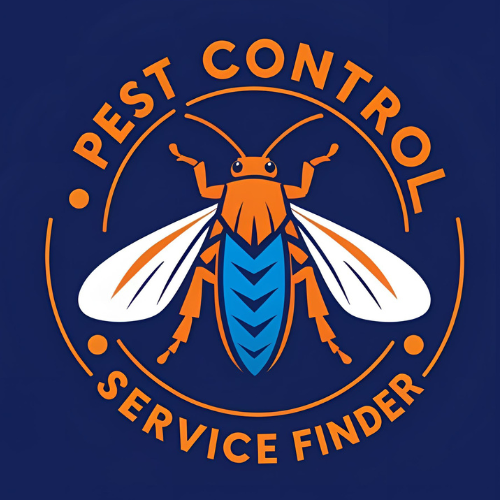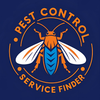How to Kill Termites Naturally with Home Remedies
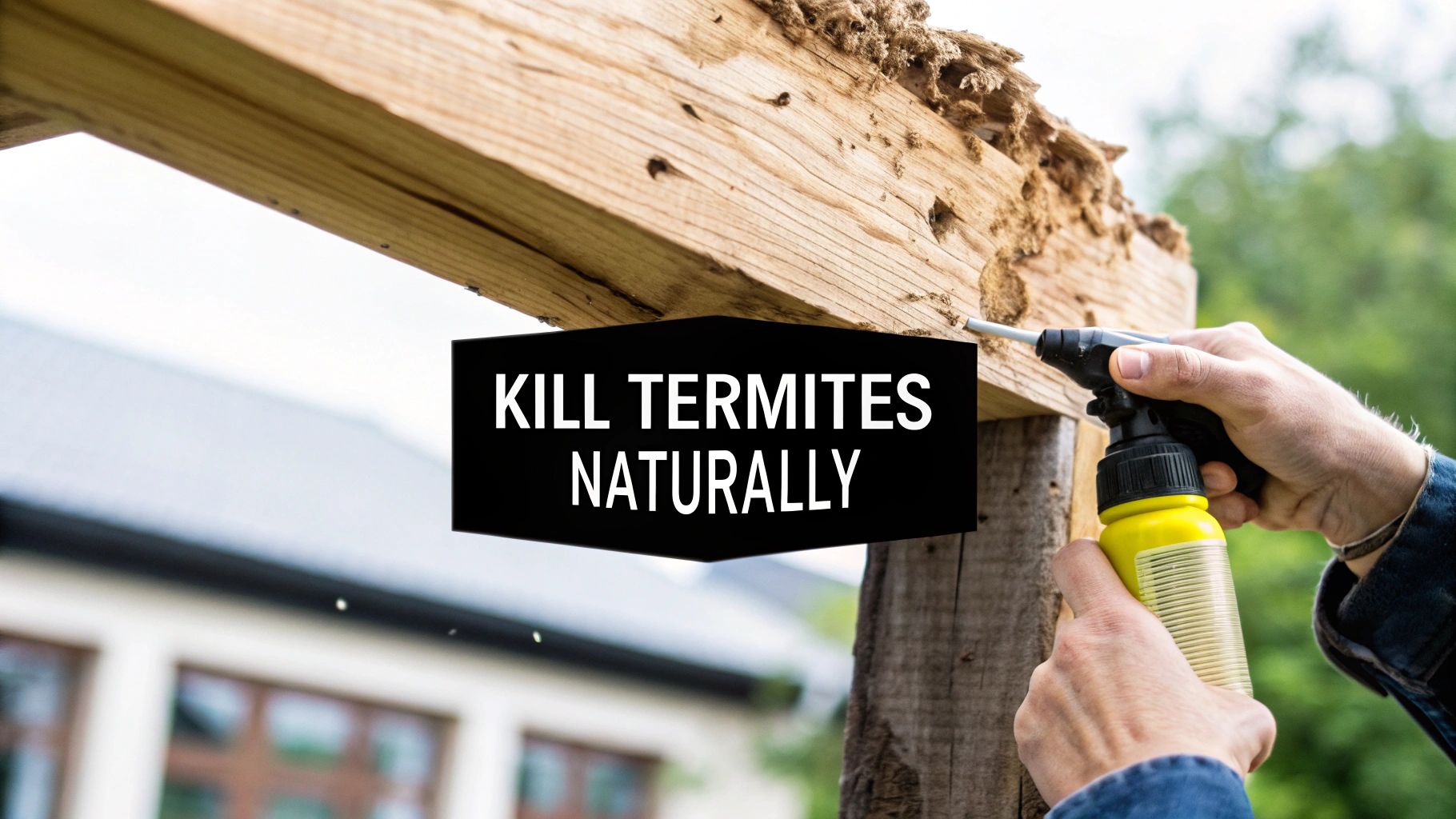
Think you might have termites? Call +1 855 224 3071 for immediate help. Before you can learn how to kill termites naturally, you first need to be sure that's what you're dealing with. You can do this yourself by looking for dead giveaways like pencil-thin mud tubes along your foundation, little piles of discarded wings near windows, or wood that sounds hollow when you tap it.
Identifying a Termite Problem Before You Act
Before jumping into any natural remedy, you have to be positive you've got termites and get a sense of how bad the problem is. If you use the wrong treatment, you’re just giving the termites more time to chew through your home, which means more damage and higher repair bills. This initial inspection is the single most important step. Think of yourself as a detective, hunting for the clues these silent destroyers leave behind. For a professional opinion, Call +1 855 224 3071.
For many homeowners, the first clue is a termite swarm. Finding piles of discarded wings on your windowsills or near lights is a sure sign a mature colony is close by and trying to expand.
Telltale Signs of an Infestation
Knowing what to look for is half the battle. A lot of people get confused between termites and flying ants, but once you know the difference, it's easy to spot. Termites have straight antennae, a thick waist, and two sets of wings that are the same length. Flying ants, on the other hand, have bent antennae, a skinny "pinched" waist, and wings that are different lengths.
Here are the main things to look for:
- Mud Tubes: Subterranean termites build these little protected highways, about as wide as a pencil, to get from their colony in the soil to the wood in your house. Be sure to check your foundation, in crawl spaces, and around support beams.
- Hollow-Sounding Wood: Go around and tap on wooden structures like beams, flooring, or window frames. If it sounds hollow or papery, that’s a big red flag that termites have been eating it from the inside out.
- Frass (Termite Droppings): This is a sign of drywood termites. They push their tiny fecal pellets out of the wood they're living in. Look for small piles of what looks like sawdust or coffee grounds.
The demand for safe, eco-friendly pest solutions is growing fast. The global termite control market, valued at around $3 billion in 2025, is expected to keep climbing as more people realize how expensive termite damage can be. While traditional chemical treatments are still out there, natural methods like orange oil and beneficial nematodes are becoming really popular, especially with environmentally conscious homeowners. People want solutions that work without harming the environment or other critters. You can discover more insights about the evolving termite control market and see the trends for yourself.
Key Takeaway: Getting the identification right from the start is absolutely critical. Mistaking termites for ants or just missing the early signs can lead to major delays in treatment and cost you thousands in structural repairs down the road. When in doubt, it’s always better to be safe and Call +1 855 224 3071 for a professional assessment.
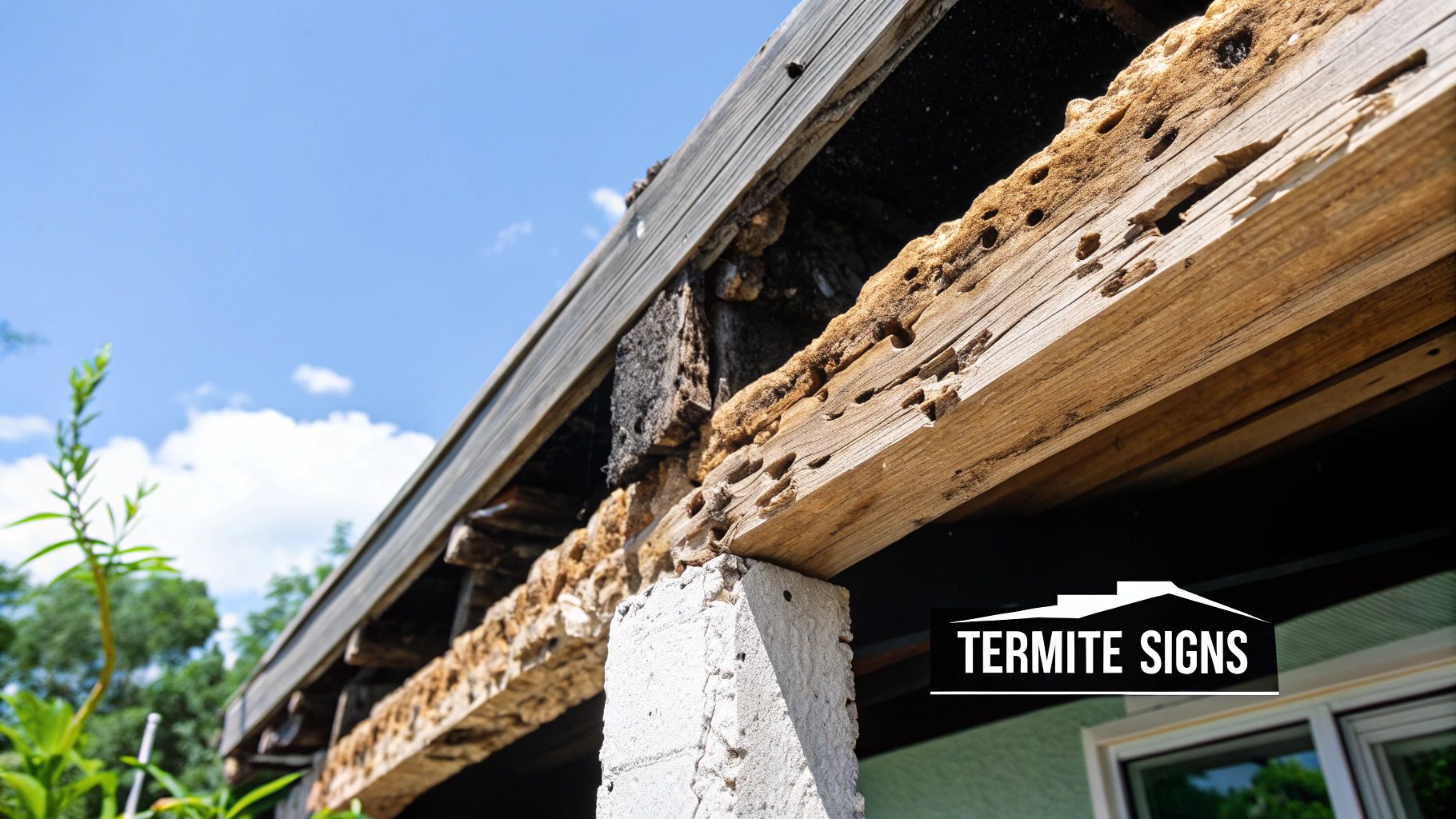
This guide covers several effective, natural solutions for termite control. To help you choose the right one, the table below provides a quick summary of each method, what situations it's best for, and how effective you can expect it to be.
Quick Guide to Natural Termite Control Methods
| Natural Method | Best For | Effectiveness Level |
|---|---|---|
| Beneficial Nematodes | Subterranean termites; outdoor soil treatment | High |
| Diatomaceous Earth | Spot treatments; creating barriers | Moderate |
| Boric Acid | Direct wood treatment; bait stations | High |
| Orange Oil | Drywood termites; direct injection | Moderate to High |
| Cardboard Traps | Monitoring; reducing small colonies | Low to Moderate |
| Sunlight Exposure | Infested furniture; small wood items | Moderate |
Using this table can help you narrow down your options based on the type of termite you have and the scale of your infestation before diving into the detailed steps for each method.
Not sure which natural liquid treatment is the right call for your problem? Call +1 855 224 3071 to get some straightforward advice from a pro.
When you've got a visible termite problem and you're ready to hit it hard, natural liquid treatments are the way to go. These are direct, on-contact solutions perfect for spot-treating infestations you can actually see and get to.
This isn't like using baits where you have to wait for termites to carry poison back home. Liquid treatments get you immediate results. Let's dig into some of the best options you can mix up yourself.
Applying Natural Liquid Termite Treatments
Think of liquid treatments as your targeted strike force. They're surprisingly effective whether you're fighting a small colony that's taken up residence in an old piece of furniture or creating a defensive perimeter around your house. The real trick is knowing which mix to use and how to apply it for the biggest impact.
For anyone researching how to kill termites naturally, orange oil and neem oil are usually the first things they come across. There's a good reason for that—they're easy to find and backed by science for their effectiveness against these wood-eaters.
Orange Oil and Neem Oil Solutions
Orange oil is a powerhouse contact killer. The magic ingredient here is D-limonene, which is absolutely lethal to termites. It works by dissolving their exoskeletons, which causes them to dehydrate and die off fast. This makes it the perfect choice for injecting directly into termite tunnels inside wooden beams or furniture.
Neem oil plays a different game. It’s not an instant kill; instead, it messes with their biology, acting as a growth regulator. When a termite eats it, the oil screws up their hormones. They can't molt, they can't reproduce, and they eventually stop eating. It’s a slower process, but it leads to a total colony collapse from the inside out.
Here’s how to mix up a batch:
- Orange Oil Mix: Grab a spray bottle and add two cups of water, a few drops of dish soap, and about 30 drops of pure orange oil. The soap is crucial because it helps the oil and water actually mix.
- Neem Oil Mix: In a separate bottle, mix two cups of water with one teaspoon of neem oil and about a half teaspoon of a mild liquid soap. You’ll need to shake this one well before you use it each time.
Application is key. If you're dealing with tiny cracks or holes, a syringe is your best friend for getting the liquid deep into those termite galleries. For bigger jobs like a fence line or a deck, a simple garden sprayer will get the job done.
The Power of a Simple Vinegar Spray
You don't always need to buy special oils. Something you probably already have in your pantry, white vinegar, can work in a pinch. The acetic acid in vinegar is deadly to termites on direct contact. It might not have the deep-penetrating power of orange oil for a serious infestation, but for surface-level skirmishes, it's a great tool.
Just mix one part white vinegar with one part water. If you want to give it a little extra kick, squeeze in the juice from a lemon. Spray this concoction right on the termites and any wood they're munching on. It’s a fast, cheap, and non-toxic fix for minor issues.
Real-World Scenario: Let's say you spot termites chewing away at a wooden fence post in your yard. Don't panic. Mix up an orange oil spray, grab your garden sprayer, and completely soak the post. Make sure the liquid gets into every nook and cranny. Check back in a week, and you'll likely find no signs of life. This is a perfect example of how to kill termites naturally in a localized, outdoor spot. Of course, for anything bigger or inside your home's structure, it's always smarter to Call +1 855 224 3071.
Struggling to figure out the best spot for natural termite baits? Call +1 855 224 3071 for professional placement advice.
While a liquid treatment can give you a quick knockdown, it's not always the right tool for the job. Getting spray into hidden areas like wall voids or across a massive crawl space can be next to impossible. This is exactly where solid and bait-based methods come in—they offer a powerful, long-term strategy designed for total colony elimination.
Using Natural Solids and Baits for Lasting Control
Instead of a direct, immediate assault, solids and baits are all about playing the long game. The genius behind this approach is using the termites' own social behavior against them. You essentially turn the worker termites into unwitting assassins, carrying the poison back to the very heart of the colony.
It's a method that requires some patience, but the payoff is huge: the potential to wipe out the entire infestation, queen and all.
When you're looking at how to kill termites naturally, two of the most effective and accessible solids are Diatomaceous Earth (DE) and Borax. Both are natural minerals, but they attack termites in completely different—and equally lethal—ways.
The Power of Diatomaceous Earth
Diatomaceous Earth, or DE, is a fine, talc-like powder that comes from the fossilized remains of tiny aquatic organisms. To us, it feels soft. But on a microscopic level, it's a field of razor-sharp shards.
When termites crawl through DE, it slices through their waxy outer exoskeleton. This causes them to lose moisture rapidly, dehydrate, and die. It's a purely physical kill, not a chemical one.
The key to success is strategic application. Grab a powder duster and lightly puff the DE into hidden areas where you suspect activity:
- Inside wall voids (you can go through electrical outlets or drill small, discreet holes)
- Throughout attics and hard-to-reach crawl spaces
- Behind baseboards, under cabinets, and in pipe chases
This creates a deadly barrier that termites can't cross without getting torn up, making it a fantastic defensive line inside your home's structure.
Creating Your Own Borax Bait Stations
Borax, and its refined form boric acid, is a natural mineral that acts as a potent stomach poison for termites. But the real brilliance of a bait station is that it doesn't just kill the termites that find it. It uses them to poison the entire nest.
Worker termites are tricked into eating the borax-laced bait. They then carry it back to share with the rest of the colony through a process called trophallaxis, eventually reaching the queen.
This visual shows the basic concept of a DIY trap, which is the foundation of a homemade baiting system.

As the image shows, you can use simple materials like wood and jars to create monitoring stations or deliver bait directly to foraging termites. It's a surprisingly effective setup.
You can set up your own bait easily. You'll need some cardboard—termites can't resist the cellulose—and a simple borax solution.
- First, prepare the bait. Mix one part borax with three parts sugar. Add just enough water to create a thick paste. The sugar is crucial; it's what draws the termites in.
- Next, soak the cardboard. Take pieces of corrugated cardboard and smear the paste all over them, making sure it gets deep into the ridges.
- Finally, place your traps. Put these bait-laced cardboard pieces in areas where you've seen termite activity, like near mud tubes, in damp corners of your basement, or against foundation walls.
You have to be patient with this one. A baiting strategy can take several weeks or even a couple of months to show full results. The poison needs time to circulate through the entire colony. If you don't see results or the infestation seems to be getting worse, that's a clear sign you need professional help. Call +1 855 224 3071 to connect with an expert right away.
Comparing Liquid vs Solid Natural Treatments
Trying to decide whether a liquid or solid treatment is the right fit for your termite problem? This table breaks down the pros and cons to help you weigh your options.
| Factor | Liquid Treatments (Orange Oil, Neem Oil) | Solid/Bait Treatments (DE, Borax) |
|---|---|---|
| Speed of Action | Fast-acting; kills on contact for immediate results in treated areas. | Slow-acting; requires time for termites to spread the bait to the colony. |
| Target Area | Best for localized, accessible infestations on wood surfaces. | Excellent for hidden areas like wall voids, crawl spaces, and colony elimination. |
| Application Method | Applied as a direct spray or injection into infested wood. | Applied as a dust (DE) or placed in bait stations (Borax). |
| Primary Goal | Quick knockdown and spot treatment of active termites. | Long-term control and complete eradication of the entire colony, including the queen. |
| Residual Effect | Limited residual effect; may require reapplication over time. | Long-lasting barrier (DE) or continuous baiting until the colony is gone. |
Ultimately, liquid treatments are great for a quick fix on a visible problem, while solids and baits are your go-to for a strategic, long-term solution aimed at wiping out the source.
For professional guidance on using natural termite defenses, Call +1 855 224 3071 to speak with a specialist.
Unleashing Beneficial Nematodes as a Natural Defense
What if you could deploy a microscopic army to hunt and kill termites right where they live? That’s exactly what beneficial nematodes do.
These are tiny, naturally occurring parasitic worms that are absolute assassins for subterranean termites but are completely harmless to people, pets, and your garden plants. They are one of the best tools in the natural pest control playbook.
Once you release them, these microscopic organisms actively seek out termite larvae in the soil. They burrow into the termites, releasing a specific bacteria that kills the host within a lightning-fast 24-48 hours. This process turns the soil around your foundation into a living, self-sustaining barrier against termite colonies.
How to Apply Your Nematode Army
Putting your nematode army to work is surprisingly straightforward—no professional gear required. You can find them online or at most garden supply stores, usually arriving dormant on a small sponge or as a powder.
To wake them up, just mix the nematodes with water according to the instructions on the package. You can apply the solution with a simple watering can or a pump sprayer. The real key is getting them exactly where subterranean termites are most likely to be.
Focus your application on these high-priority zones:
- The soil pushed right up against your home's foundation.
- The ground surrounding any wood structures, like decks, sheds, or fence posts.
- Mulch beds and garden areas close to the house, as these spots hold moisture and attract termites.
For these little warriors to do their job, they need the right conditions. Direct sunlight is their enemy, so it's best to apply them in the evening or on an overcast day. Make sure the soil is damp before you start and give it a light watering afterward; this helps them move freely to hunt down their prey. If you're unsure about timing it right, Call +1 855 224 3071 for some expert advice.
Ensuring Maximum Effectiveness
Timing and conditions are everything when it comes to nematodes. The soil needs to be above 60°F for them to become active and start hunting. After you've applied them, a gentle watering helps wash them down into the soil where they can get straight to work.
The demand for effective termite solutions is massive. Globally, the termite control market was valued at around $2.9 billion in 2021, with significant growth expected, particularly in termite-prone regions like the Asia-Pacific. In these areas, there's a growing trend of integrating natural strategies like nematodes alongside traditional methods. This highlights a worldwide shift toward safer, more eco-friendly pest control. You can learn more about the global termite control market and see these trends for yourself.
Expert Tip: Think of beneficial nematodes as a preventative measure. By reapplying them once or twice a year, you maintain a strong defensive line in your soil. This makes your property a hostile environment for any new termite colonies trying to get established and is one of the most effective ways to kill termites naturally before they cause real damage.
If you're dealing with a serious infestation, don't waste another minute. Call +1 855 224 3071 for immediate help from a professional.
Creating a Termite-Proof Home Environment
Killing the termites you can see is just the opening battle. The real war is won by making your home a place they never want to visit again.
Long-term prevention is all about turning your property from a termite buffet into a fortress they can't even get near. This comes down to a few powerful, but simple, home maintenance habits.
It all starts with making the environment right outside your door hostile to them. Subterranean termites, the most common culprits, need two main things to survive: wood (their food) and moisture. Take those away, and you've essentially rolled up their welcome mat. This is the core of killing termites naturally and keeping them out for good.
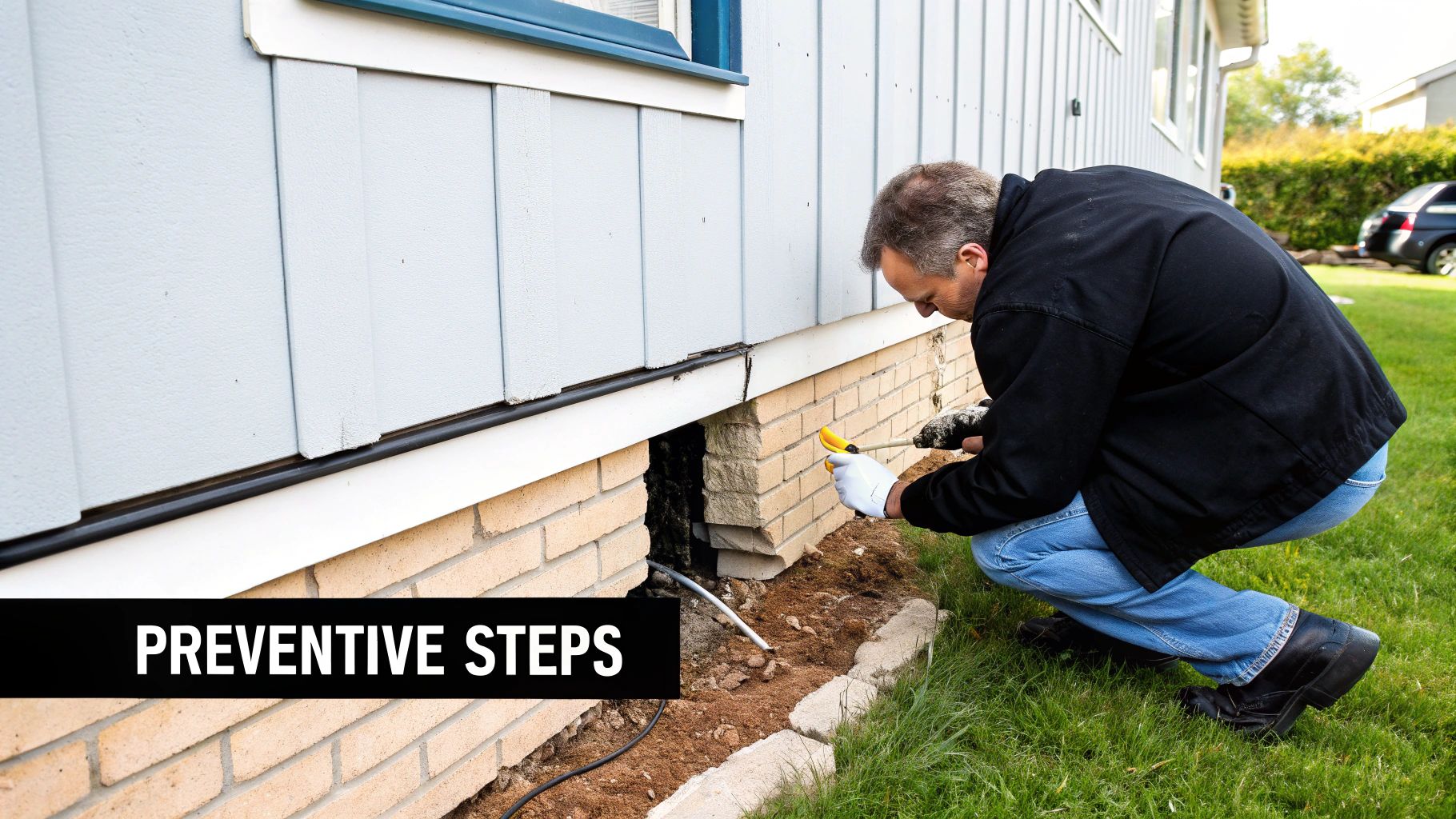
Sealing Off Termite Entry Points
Your job is to make your home as unappealing as humanly possible. Termites are relentless opportunists, and they will find and exploit any weakness in your home's defenses. A few consistent efforts to cut off their resources will make a world of difference.
Here’s where to focus your energy:
- Create a Mulch-Free Zone: Keep a barrier of at least 18 inches between any wood mulch and your home's foundation. This simple gap removes a direct food bridge to your house.
- Eliminate Moisture Sources: Get in the habit of checking for leaky outdoor faucets, dripping AC units, and clogged gutters. Termites are drawn to water, so dry soil around your foundation makes your property a lot less attractive.
- Seal Foundation Cracks: Do a thorough walk-around and inspect your foundation for any cracks or gaps. Seal them up tight. Termites can squeeze through an opening as tiny as 1/32 of an inch.
The economic damage from termites is no joke, costing over $40 billion globally every single year. A big part of the problem is how easily they spread through human activity. Invasive species like the Formosan termite can hitch a ride on things like recreational boats, letting them set up shop thousands of miles from home. Knowing how they travel is crucial for preventing their spread.
Knowing When to Call for Help
Look, DIY natural methods are fantastic for prevention and handling very minor issues. But you have to be realistic about their limits. If you've found widespread damage, are seeing swarms of termites inside your home, or notice structural red flags like sagging floors, you're way past a DIY fix.
Critical Takeaway: Trying to tackle a large, established termite colony with natural methods alone is a recipe for disaster. It just gives them more time to cause thousands of dollars in structural damage.
In these cases, the smartest and safest thing you can do is call a professional immediately. A serious infestation needs specialized equipment, targeted treatments, and an expert's eye. Don’t gamble with the integrity of your home.
If the signs point to a big problem, Call +1 855 224 3071 to protect your property before the damage gets worse. For more practical pest control advice, feel free to check out other topics on our blog at https://pestcontrol-service-finder.com/blog/.
Confused about the details of natural termite control? For clear answers and professional advice, Call +1 855 224 3071 to speak with an expert.
Frequently Asked Questions About Natural Termite Control
Trying to tackle termites on your own naturally brings up a ton of questions. Before you dive in, getting the right answers is key to making sure you pick the best approach for your home and know exactly what you’re getting into.
Here are the straight answers to the most common questions homeowners have when they're figuring out how to kill termites naturally.
How Long Does It Take for Natural Methods to Kill Termites?
The honest answer? It really depends. You're looking at a classic trade-off between instant action and a long-game strategy.
Some treatments, like a direct spray of orange oil or vinegar, are designed to kill on contact. If you can see the termites and hit them directly, they’ll die almost immediately. This is great for a tiny, visible problem you can easily get to.
On the other hand, solutions meant to wipe out the whole colony, like borax baits or beneficial nematodes, take a lot more patience.
- Borax Baits: Expect these to take several weeks, or even a few months, to really work. Worker termites have to find the bait, haul it back to the nest, and then share it with the rest of the colony. It's a slow burn.
- Beneficial Nematodes: You might see fewer termites within a week or two, but it takes time for the nematodes to really build up their numbers and hunt down the entire colony.
The trick is matching the speed of the method to the severity of your problem.
Are Natural Termite Treatments Safe for Pets and Children?
This is a big reason people choose natural methods—they are far safer than traditional chemical pesticides. But "safer" doesn't mean you can throw caution to the wind.
Beneficial nematodes are totally harmless to people, pets, and plants. You don't have to worry about them at all. Diatomaceous Earth is non-toxic if accidentally eaten, but it’s a fine dust that can irritate lungs, so always wear a mask when you're applying it.
Borax is a natural mineral, but it’s toxic if ingested. That means any borax baits must be placed well out of reach of curious kids or pets. If you need professionally applied, family-safe options, Call +1 855 224 3071.
Important Reminder: No matter what you use, always read and follow the application instructions on the label. Your family's safety has to be the number one priority.
Can DIY Natural Methods Handle a Large Termite Infestation?
This is probably the most critical question to ask yourself. For small-scale issues—like finding termites in an old wooden chair in the garage—or as part of an ongoing prevention plan, natural methods are fantastic.
But they just don't have the knockout power needed for a large, established colony that’s already munching on your home’s structure. Widespread infestations that threaten your foundation or walls need a much more aggressive and comprehensive treatment plan.
If you even suspect the problem is big, DIY treatments are like putting a bandage on a broken arm—they won't fix the real issue. In these cases, calling in a professional is the only way to prevent truly catastrophic and expensive damage.
When DIY isn't enough, Pest Control Service Finder connects you with local, vetted exterminators who can handle any size infestation. Get a no-obligation quote and reclaim your home by visiting https://pestcontrol-service-finder.com.
